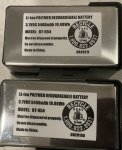I am no where near an expert on this subject but will chime in with my past experience of having 2 uniden sds-100 batteries puff up on me and also being a radio controlled car enthusiast. These are Li-Ion POLYMER (LiPO) batteries. they have different behavior compared to Li-Ion's. The people that torture the LiPOs the most are the guys that race RC cars, planes, drones, etc. Check out some of their videos on youtube such as LiPO fires, tips, care, dangers, etc. they are charging up to 3C in some occasions (high current) and the voltage in each cell or "S" (example: 2S, 3S, and so on) must be precision monitored so that the "pack" of cells (2 or more) doesn't continue charging when one of the cells reaches 4.2V. every cell is monitored and the idea is to keep the cells matched when charging and not to over charge them. Some guys will toss their packs if there's a difference of 50mV between cells.
Yes the sds-100 does have a smart charge feature, but i'm not certain that it works 100%. you can enable in the menu to show the voltage, usb1, and usb2 current. I've seen the voltage go as high as 4.24V before the radio switches itself from red (charging) to green (not charging). a "storage" charge, or the level which is deemed the most safe is 3.7V, the nominal voltage of the pack. remember each LiPO "cell" is 3.7VDC. discharge is also critical like mentioned in a post above, if one of the cells goes below 3VDC and you don't charge it or bring it up to storage charge then it can have irreversible damage.
The most danger with these types of packs is overcharging. if held at max charge sometimes the packs will swell. if you short these out, or puncture them it will likely puff up and explode. again check youtube videos for LiPO behavior. I've been rolling the dice with these LiPO packs in the sds. I've had 2 swell up in less than a year, i'm sure you're familiar with my photos in a previous post. My sds100 LiPO sits in a metal can in the garage under a heat detector in the event it decides to take a poop.
I have 2 million dollar questions, 1) why does uniden continue to let these packs go out the door knowing there are multiple reports of swelling batteries, and 2) looking at the photos of my battery that swelled up so much that it split itself wide open - it appears that this is a 3S or 3-cell pack, but there are only 3 contacts on the top. there technically should be 4. Maybe this is why some (not all) packs are overcharging andsome (not all) are swelling? I stored a fully charged pack for a month with no swelling, and it's now sitting in the garage at storage voltage. If there are any changes i'll update my other post. To close, they also make LiPO storage bags so that when you're not using your remote controlled toy, you store the batteries in a bag. some are decent, but the best method to store a LiPO is in a metal container, like an empty tool box or a BBQ grill and placed somewhere that you don't mind smoke damage. Paranoid yet?



